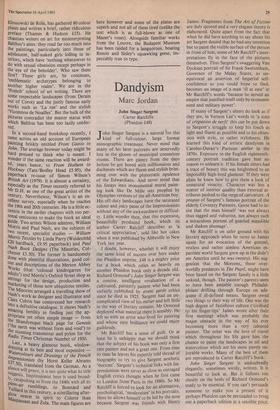Dandyism
Marc Jordan
John Singer Sargent Carter Ratcliffe (Phaidon £48)
John Singer Sargent is a natural for this kind of full-colour, large format monographic treatment. Never mind that many of his later portraits are deservedly lost in the gloom of municipal committee rooms. There are plenty from the days before he got bored with milllionaires and duchesses which are fluent and stylish brim- ming over with the plutocratic opulence of the Edwardians. And never mind that his forays into monumental mural paint- ing look like De Mille sets peopled by Olympian versions of the all-American boy. His off-duty landscapes have the saturated colour and juicy paint of the Impressionists without any of the awkwardness or difficul- ty. Little wonder then, that this expensive, beautifully produced book, which its author Carter Ratcliff describes as 'a critical appreciation', sold like hot cakes when it was published by Abbeville in New York last year.
I doubt, however, whether it will enjoy the same kind of success over here under the Phaidon imprint. £48 is a mighty price for a book which relies so heavily on another Phaidon book only a decade old. Richard Ormond's John Singer Sargent was a concise, intelligent revaluation of a cultivated, painterly painter who had been unfairly rubbished by avant garde critics since he died in 1925. Sargent had an un- complicated view of his metier and left little in the way of literary remains. Mr Ormond deployed what material there is sensibly. He left us with an artist who lived for painting and whose easy brilliance we could enjoy guiltlessly.
Mr Ratcliff has a sense of guilt. Or at least he is unhappy that we should think that the subject of his book was only a first rate painter and not a great one. From time to time he leaves his expertly told thread of biography to try to give Sargent aesthetic 'bottom'. Sargent's technical links with Im- pressionism were never as close as outraged English critics thought when he first came to London from Paris in the 1880s. So Mr Ratcliff is forced to look for an alternative, psychological, 'modernism' in his portraits. Here he allows himself to be led by the nose because Sargent was friends with Henry
James. Fragments from The Art of Fiction are duly quoted and a very elegant theory is
elaborated. Quite apart from the fact that when he did have anything to say about his art Sargent denied that he had any intention but to paint the visible surface of the person in front of him, some of Mr Ratclifr s inter- pretations fly in the face of the pictures themselves. Thus Sargent's swaggering Van Dyckian portrait of Sir Frank Swettenham, Governor of the Malay States, as un- equivocal an assertion of Imperial self- confidence as you could hope to find, becomes an image of a man 'ill at ease' in Mr Ratclifrs words 'because he served an empire that justified itself only by economic need and military power'.
If many of Sargent's sitters do look as if they are, in Vernon Lee's words in 'a state
of crispation de nerfs' this can be put down to Sargent's struggle to keep his touch as light and fluent as possible and to his obses- sion with style, or rather stylishness. He learned this kind of artistic dandyism in Carolus-Duran's Parisian atelier in the 1870s. Exposure to the English eighteenth- century portrait tradition gave him no reason to unlearn it. If his female sitters had a trace of beauty this was heightened to an impossibly high-bred glamour. If they were plain he knew how to give them a look of unnatural vivacity. Character was less a matter of interior quality than external at- tributes pushed to the verge of caricature. A propos of Sargent's famous portrait of the elderly Coventry Patmore, Gosse had to in- sist that the man himself 'was not always thus ragged and vulturine, not always such a miraculous portent of gnarled mandible and shaken plumage'.
Mr Ratcliff is on safer ground with his literary approach when he turns to James again for an evocation of the genteel, restless and rather aimless American ex- patriate world Sargent grew up in (he didn't see America until he was twenty). His sug- gestion that the Moreens, those over- worldly predators in The Pupil, might have been based on the Sargent family is a little unkind, though. The painter's parents seem to have been amiable enough Philadel- phians drifting through Europe on ade- quate if ill-defined means. Sargent owed two things to their way of life. One was the high degree of fastidious culture ('civilised tp his finger-tips' James wrote after their first meeting) which was probably the major obstacle in the way of his ever becoming more than a very talented painter. The other was the love of travel which throughout his life gave him the chance to paint the landscapes in oil and watercolour which are his most purely en- joyable works. Many of the best of them are reproduced in Carter Ratcliff's book.
John Singer Sargent is undoubtedly elegantly, sometimes wittily, written. It is beautiful to look at. But it follows too closely on the heels of Richard Ormond's study to be essential. If you can't persuade someone to make you a present of it perhaps Phaidon can be persuaded to bring out a paperback edition at a sensible price.










































 Previous page
Previous page